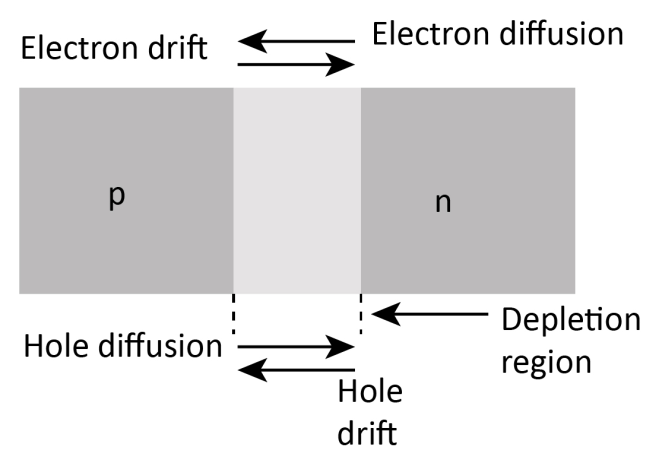
The drift current in p-n junction is
A. from the n- side to the p- side
B. from the p- side to the n- side
C. from the n- side to the p-side if the junction is forward- biased and in the opposite direction if it is reverse biased
D. from the p- side to the n-side if the junction is forward- biased and in the opposite direction if it is reverse biased
Answer
513.6k+ views
Hint: In p- n junction, holes from p side and electrons from n side start moving to the opposite side. The movement of electron and holes gives rise to a potential difference, which set up barrier field and starts pushing electrons towards n- side and holes towards p- side
Complete answer:
When the p- n junction is created, the p- side of the junction has higher concentration of holes whereas n- side has higher concentration of electrons. Because of this concentration difference, the electrons begin to move from n- side to p- side whereas holes begin to move from p- side to n – side. This results in the depletion region and this forms an electric field close to the junction from the n- p side.
The formation of the p- n junction is shown in the figure below:

Any electron is pushed by this electric field to the p- side and any hole is pushed by the electric field to the n –side. This results in a potential difference across the junction also known as the potential barrier.
The barrier potential develops a barrier field in the direction n to p side. This barrier field immediately pushes the electron towards the n- side and holes towards the p- side, and then a current is set up by the barrier field from n to p side. This current is known as drift current.
Note:
The movement of majority charge carriers across the junction results in an electric current from p to n side and this current is called diffusion current.
The drift and diffusion current directions are opposite.
The electrons begin to move from n- side to p- side whereas holes begin to move from p- side to n – side.
Complete answer:
When the p- n junction is created, the p- side of the junction has higher concentration of holes whereas n- side has higher concentration of electrons. Because of this concentration difference, the electrons begin to move from n- side to p- side whereas holes begin to move from p- side to n – side. This results in the depletion region and this forms an electric field close to the junction from the n- p side.
The formation of the p- n junction is shown in the figure below:

Any electron is pushed by this electric field to the p- side and any hole is pushed by the electric field to the n –side. This results in a potential difference across the junction also known as the potential barrier.
The barrier potential develops a barrier field in the direction n to p side. This barrier field immediately pushes the electron towards the n- side and holes towards the p- side, and then a current is set up by the barrier field from n to p side. This current is known as drift current.
Note:
The movement of majority charge carriers across the junction results in an electric current from p to n side and this current is called diffusion current.
The drift and diffusion current directions are opposite.
The electrons begin to move from n- side to p- side whereas holes begin to move from p- side to n – side.
Recently Updated Pages
Master Class 12 Biology: Engaging Questions & Answers for Success

Master Class 12 Physics: Engaging Questions & Answers for Success

Master Class 12 Economics: Engaging Questions & Answers for Success

Master Class 12 Maths: Engaging Questions & Answers for Success

Master Class 11 Economics: Engaging Questions & Answers for Success

Master Class 11 Accountancy: Engaging Questions & Answers for Success

Trending doubts
Which are the Top 10 Largest Countries of the World?

Differentiate between homogeneous and heterogeneous class 12 chemistry CBSE

Why is the cell called the structural and functional class 12 biology CBSE

a Tabulate the differences in the characteristics of class 12 chemistry CBSE

Who discovered the cell and how class 12 biology CBSE

Draw a labelled sketch of the human eye class 12 physics CBSE




